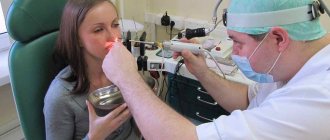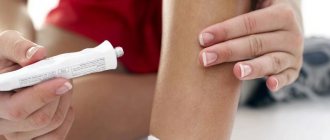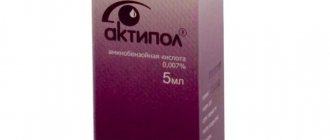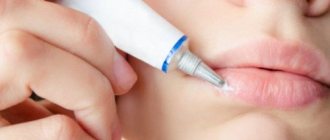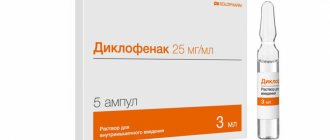Nonsteroidal anti-inflammatory drugs (NSAIDs) are one of the most popular pharmaceutical products. They are prescribed during the treatment of a number of diseases and conditions, often in entire courses. Even with clear instructions from the attending physician, many compatriots have doubts and look for information about drugs on the Internet. And then they come to the pharmacy and ask the pharmacist questions, hoping to justify their guesses or dispel doubts. In this situation, the head manager needs, on the one hand, to help the pharmacy visitor, and on the other hand, not to take on the role of a doctor. It is in this vein that we will cover the topic of topical NSAIDs today - in the form of competent answers to customer questions.
What does “when used correctly” mean? Anointed, and that’s it.
It is advisable to rub in topical forms of NSAIDs for a while rather than just apply them. The analgesic and anti-inflammatory effect of the ointment will be much higher if you do not just “anoint” it, but actively rub the product into the skin over the sore spot for some time. In the course of relevant studies, it was found that even 45 seconds of rubbing diclofenac diethylamine gel five times increased the transdermal delivery of the drug compared to simple application to the skin. And you need to remember that pain-relieving ointments based on NSAIDs act on areas of pain located immediately under the skin. If we talk about joints, then these are the knees, elbows and small joints of the hands. The local form most likely “will not reach the hip joint.” It should be rubbed “around the circumference” of the limb, for example, not only into the dorsum, but also into the palmar surface of the interphalangeal joint [6, 7].
Ointments and creams for dermatitis
Creams or ointments for dermatitis have slightly different compositions. Thus, the ointment is made on a fat basis, which can be used as vegetable or mineral oils or animal fats. Such products have a dense, slightly viscous structure. They are not immediately absorbed into the skin, but penetrate into its deeper layers. Ointments are not recommended for treating wet surfaces. They are much more effective against dry rashes and chronic inflammation.
Creams have a different base - hydrophilic. Thanks to this, they have a lighter structure, are well absorbed and do not leave greasy marks on the skin. The creams are suitable for the treatment of moderately weeping rashes; they are used for acute inflammation, for lesions of the facial skin and areas with a large number of sebaceous glands, where the use of oily products is undesirable.
Let's consider several options for dermatitis remedies used in medical practice:
- hormonal ointments with pronounced antiallergic and anti-inflammatory effects, which include topical corticosteroids;
- non-hormonal topical agents that have anti-inflammatory and antibacterial effects, relieve itching and promote wound healing.
Non-hormonal drugs
Non-hormonal creams do not contain corticosteroids. The composition may be based primarily on plant components, or not contain them at all. These medications do not act quickly. Their main advantage is the possibility of using them for a long time, including in children. Among non-hormonal creams and ointments there are products with antiseptic, anti-inflammatory, moisturizing, and regenerating effects.
Hormonal drugs
Hormonal ointments and creams in the treatment of dermatitis are considered more effective than non-hormonal ones. The drugs can contain either one active component (topical glucocorticosteroid) or have a complex effect due to the presence of an antibiotic and an antifungal agent in the composition. The use of combined drugs is advisable in case of a complicated course of the disease, when a secondary bacterial or fungal infection is added to the inflammation.
Treatment of atopic dermatitis
To achieve maximum effectiveness from therapy, it is recommended to follow an integrated approach:
- identify and, if possible, eliminate the factors causing atopic dermatitis;
- drug therapy with local agents, selected depending on the severity and form of inflammation;
- proper skin care using moisturizers and softening agents (emollients).[4]
Akriderm preparations are products for the local treatment of manifestations of atopic dermatitis with a wide spectrum of action, produced in the form of cream and ointment of 15 g and 30 g. Depending on the severity, localization, form and course of the disease, the drug is selected:
- with one active ingredient – Akriderm® ointment and cream;
- combined preparations “hormone + antibiotic” - ointments and creams Akriderm GENTA;
- combined preparations “hormone + antibiotic + antimicrobial component” - ointments and creams Akriderm GK.
The modern drug Akriderm GK is a potent drug[5] and has 4 effects at once:
- anti-inflammatory;
- antiallergic;
- antibacterial;
- antifungal. [6]
Treatment of seborrheic dermatitis
The cause of seborrheic dermatitis is infection of the skin by the yeast-like fungus Malassezia. For its treatment, external antimycotics or antifungal drugs are prescribed. Akriderm SK ointment contains betamethasone and salicylic acid. The drug has anti-inflammatory, anti-allergic, anti-exudative, anti-edematous and antipruritic effects, inhibits the accumulation of leukocytes, inhibits phagocytosis, reduces vascular tissue permeability, and prevents the formation of inflammatory edema. As a result of use, the microflora of the skin is restored, scales are exfoliated and sebum production is normalized.[7]
Treatment of allergic dermatitis
To successfully treat allergic dermatitis, it is first necessary to determine the allergen that provoked the disease and partially or even completely eliminate the provoking substance. In the acute period, a specialist may prescribe the use of compresses with cold water and tanning decoctions, which are applied every 3-4 hours for 15 minutes. This helps reduce skin weeping. Drug treatment involves the use of topical glucocorticosteroids in the form of ointments and creams, which are selected depending on the form and severity of inflammation.[8]
If allergic dermatitis is complicated by a microbial infection, it is recommended to use combined external medications, such as Akriderm GK, which, in addition to GCS, contain an antibiotic (gentamicin) and an antifungal component (clotrimazole).
Remember that treatment of dermatitis and selection of medications is carried out only by a specialist dermatologist after a preliminary consultation and examination of the patient.
Which topical NSAID is best?
Everything is individual. If the analgesic effect of oral and injectable forms of NSAIDs can be more or less ranked, then an objective comparative assessment of topical drugs is very difficult. The reason for this is that, along with the actual active substance, the intensity of rubbing, excipients (for example, dimethyl sulfoxide) and the placebo effect play a significant role. Most studies on the effectiveness of topical NSAIDs have focused on diclofenac and ketoprofen. The increased attention to them is due to the fact that diclofenac is the only NSAID whose topical forms are approved by the American Food and Drug Administration (FDA), and ketoprofen, accordingly, is approved in most other countries of the world. Reliable data comparing these two drugs with each other have not yet been published. No one questions the effectiveness of other non-steroidal anti-inflammatory drugs for external use (ibuprofen, phenylbutazone, piroxicam, nimesulide, etc.); each of them was the subject of several clinical trials at one time, but the geography of their use is much more modest and is often limited to a few developing countries [2, 8].
Do excipients in the local form of NSAIDs matter?
Yes, they improve skin permeability and perhaps enhance the therapeutic effect in a certain way. In separate studies, for example, topical formulations of diclofenac with dimethyl sulfoxide (DMSO) and diclofenac diethylamine 1.16% have been shown to penetrate the skin faster than “regular” diclofenac sodium gels. In addition, DMSO itself may have a slight anti-inflammatory effect. There is no solid evidence of an increase in the analgesic effect due to the listed supplements, but their use at least helps to overcome the individual characteristics of the skin [7, 9–11].
Can I take NSAID tablets and use the topical form at the same time?
This is not directly prohibited by the instructions for use, but it is not recommended, and, apparently, does not make sense. According to the only credible study on this topic, there was no significant increase in the analgesic effect when combining local and systemic forms of NSAIDs. At the same time, this use of drugs slightly increased the frequency of rectal bleeding. In clinical trials, oral administration of diclofenac and ibuprofen at doses 2 and 3 times higher than recommended also did not lead to increased pain relief. The effect of a combination of tablets and a topical form of NSAIDs will most likely not be pronounced. At the same time, the likelihood of unwanted reactions slightly increases. Therefore, this combination is not recommended. Usually, if a local remedy does not help, the doctor cancels it and transfers the patient to oral administration [12, 13].
Types of dermatitis and diagnosis
Depending on the causes of manifestation and the nature of the course, the following types of dermatitis are distinguished:
- simple contact;
- allergic;
- allergic contact;
- seborrheic;
- atopic.[1]
Diagnosis of dermatitis is based on examination of the patient and laboratory tests, including a general blood and urine test, a biochemical blood test, an immunological blood test to determine the level of Ig E, which makes it possible to determine the allergic nature of the disease, and allergy skin tests. Based on the research results, the doctor will be able to assess the picture of the disease and select an effective treatment regimen. In some cases, allergists, infectious disease specialists, and immunologists are invited for consultation.[2]
Is it possible to use topical NSAIDs for stomach erosions or ulcers?
According to the instructions, it can be done “with caution.” The concentration of the active substance in the blood plasma after the use of topical NSAIDs is less than 10% of that achieved by oral administration. The incidence of adverse reactions from the gastrointestinal tract when using local forms of NSAIDs does not differ from that when rubbing placebo and is significantly lower than when using systemic agents. However, just in case, these drugs are not recommended to be applied to the skin during gastrointestinal bleeding and exacerbation of gastric or duodenal ulcers [5, 14].
Interferon ointment 10g
[RU] An ointment containing recombinant a-2-interferon and CIP (complex immunoglobulin preparation) is a mixture of the above-mentioned fat-based drugs.
Complex immunoglobulin preparation - dry for enteral use, is a lyophilized protein solution containing immunoglobulins of the classes IgG, IgM, IgA, isolated from human blood plasma, tested for the absence of antibodies to HIV, hepatitis C virus and surface antigen of the hepatitis B virus. If the preparations contain normal human immunoglobulin content of IgM and IgA is less than 3%, then in CIP it is increased to 15-25%, which makes it possible to use it topically for inflammatory processes of the skin and mucous membranes, since immunoglobulins of the IgM class, due to the presence of a secretory component, are more resistant to the effects of proteolytic agents enzymes in the secretions of the mucous membranes, on the cells of which they are fixed. It has been proven that the complex immunoglobulin preparation contains specific antibodies against herpes viruses, chlamydia, staphylococcus and other pathogenic microorganisms.
Human recombinant d-2-interfron is a protein synthesized by the Pscudomonas putida strain,
The gene for human leukocyte α-2-interferon, which is identical to leukocyte d-2b-interferon, is built into its genetic apparatus. Recombinant a-2-interferon inhibits the intracellular stages of development of viruses, chlamydia, rickettsia, cytomegaloviruses, bacteria, has immunocorrective and antitumor properties, stimulates antibacterial, antiviral, antiprotozoal immunity. The combined effect of these drugs causes a powerful antimicrobial effect - both intracellular and extracellular due to direct impact on microorganisms and stimulation of immune systems. In addition, due to a significant increase in the protein content in the preparation, greater stability of interferons is ensured in the presence of aggressive factors in the secretions of the mucous membranes and discharge in the lesions of the skin and mucous membranes.
Indications for use:
- flu;
- acute respiratory diseases, contact with a patient with acute respiratory viral infection;
- herpes simplex of the skin and mucous membranes;
- herpes zoster (shingles);
- genital warts and papillomas^ chlamydia;
- urogenital mycoplasmosis;
- vaginal dysbiosis, vulvovaginitis, cervicitis;
- atonic dermatitis;
- eczema of bacterial-viral etiology;
- long-term non-healing wounds, fistulas, trophic skin ulcers;
- anal fissures.
Mode of application
An ointment containing CIP and recombinant interferon-γ-2 is applied in a thin layer to the lesions. For influenza, acute respiratory diseases, herpes, it is used 2-3 times a day for 5-7 days, for other diseases 1-2 times a day for 7-14 days.
If there is heavy discharge from the nasal cavity during acute respiratory diseases, before applying the ointment, it is advisable to use drugs such as naphthyzine, sanorin, galazolin.
Before applying the ointment, mucus should be removed from the walls of the vagina and cervix with a tampon
For abundant, overgrown genital warts and papillomas, the ointment can be used in combination with cryodestruction, electrocoagulation and chemotherapy. Moreover, it can be used both before and after destructive manipulations, which prevents the contamination of surrounding healthy tissues with viruses.
For trophic and long-term non-healing wounds, the ointment is applied along their periphery in a thin layer with light rubbing. For eczema and atonic dermatitis, the ointment is applied to the entire affected surface.
It is possible to use the ointment in combination with antibiotics and other chemotherapeutic drugs
A product that has the smell of rancid oil is not suitable for use.
Contraindications for use
Individual intolerance to the drug.
Release form
An ointment containing a complex immunobiological preparation and recombinant interferon is produced in tubes and jars of 5, 10 and 30 g.
10 g contain 500,000 IU of a-interferon.
Storage
List B Store at a temperature from +4 to +10°C in a place protected from light
Best before date
The shelf life of an ointment containing CIP and recombinant γ-2-interferon is 1 year.
The shelf life of the ointment containing KIP and recombinant γ-2-interferon is 1 year. The shelf life of the ointment containing KIP and recombinant γ-2-interferon is 1 year.
How many times a day and for how long can you apply such drugs?
Typically three to four times a day for two weeks. Topical NSAIDs act quite quickly - the effect occurs within an hour - and help control acute somatic pain of moderate intensity. They cope worse with chronic pain. If there is no effect within two weeks of proper use, you should consult a doctor. There is a chance that he will recommend switching to oral forms or another group of drugs.
Sources
- Derry S, Conaghan P, Da Silva JA, et al. Topical NSAIDs for chronic musculoskeletal pain in adults. Cochrane Database Syst Rev. 2016; 4: CD007400. https://www.cochranelibrary.com/cdsr/doi/10.1002/14651858.CD007400.pub3/full
- Derry S, Wiffen PJ, Kalso EA, et al. Topical analgesics for acute and chronic pain in adults – an overview of Cochrane Reviews. Cochrane Database Syst Rev. 2017; 5: CD008609. https://www.cochranelibrary.com/cdsr/doi/10.1002/14651858.CD008609.pub2/full
- Klinge SA, Sawyer GA. Effectiveness and safety of topical versus oral nonsteroidal anti-inflammatory drugs: a comprehensive review. Phys Sportsmed. May 2013; 41(2): 64–74. https://www.ncbi.nlm.nih.gov/pubmed/23703519
- Kloppenburg M, Kroon FP, Blanco FJ, et al. 2021 update of the EULAR recommendations for the management of hand osteoarthritis Annals of the Rheumatic Diseases 2019; 78: 16–24. https://ard.bmj.com/content/78/1/16
- Honvo G, Leclercq V, Geerinck A, et al. Safety of Topical Non-steroidal Anti-Inflammatory Drugs in Osteoarthritis: Outcomes of a Systematic Review and Meta-Analysis. Drugs Aging. 2019; 36(Suppl 1): 45–64. https://www.ncbi.nlm.nih.gov/pmc/articles/PMC6509095/
- Hasler-Nguyen N, Fotopoulos G. Effect of rubbing on the in vitro skin permeation of diclofenac-diethylamine 1.16% gel. BMC Res Notes. 2012 Jun 21; 5: 321. https://www.ncbi.nlm.nih.gov/pmc/articles/PMC3424122/
- Hagen M, Baker M. Skin penetration and tissue permeation after topical administration of diclofenac. Curr Med Res Opin. 2021 Sep; 33(9):1623–1634. https://www.tandfonline.com/doi/full/10.1080/03007995.2017.1352497
- Rafanan BS Jr, Valdecañas BF, Lim BP, et al. Consensus recommendations for managing osteoarthritic pain with topical NSAIDs in Asia-Pacific. Pain Manag. 2018; 8 (2): 115–128. https://www.futuremedicine.com/doi/10.2217/pmt-2017-0047?url_ver=Z39.88-2003&rfr_id=ori:rid:…
- Pradal J, Vallet CM, Frappin G, Bariguian F, Lombardi MS. Importance of the formulation in the skin delivery of topical diclofenac: not all topical diclofenac formulations are the same. J Pain Res. 2019; 12: 1149–1154. https://www.dovepress.com/importance-of-the-formulation-in-the-skin-delivery-of-topical-diclofen-pee…
- Galer BS. A comparative subjective assessment study of PENNSAID® and Voltaren Gel®, two topical formulations of diclofenac sodium. Pain Pract. 2011; 11 (3): 252–60. https://onlinelibrary.wiley.com/doi/abs/10.1111/j.1533-2500.2010.00420.x
- Tieppo Francio V, Davani S, Towery C, Brown TL. Oral Versus Topical Diclofenac Sodium in the Treatment of Osteoarthritis. J Pain Palliat Care Pharmacother. 2021 Jun; 31 (2): 113–120. https://www.tandfonline.com/doi/abs/10.1080/15360288.2017.1301616?journalCode=ippc20
- Simon LS, Grierson LM, Naseer Z, et al. Efficacy and safety of topical diclofenac containing dimethyl sulfoxide (DMSO) compared with those of topical placebo, DMSO vehicle and oral diclofenac for knee osteoarthritis. Pain. 2009; 143(3):238–45. https://insights.ovid.com/article/00006396-200906000-00016
- Van Amburgh J. Can Topical and Oral NSAIDs Be Combined for Pain Relief? Medscape. https://www.medscape.com/viewarticle/861740
- Roth SH. Nonsteroidal anti-inflammatory drug gastropathy: new avenues for safety. Clin Interv Aging. 2011; 6: 125–31. https://www.ncbi.nlm.nih.gov/pmc/articles/PMC3131982/
- Kowalski ML, Makowska JS, Blanca M, et al. Hypersensitivity to nonsteroidal anti-inflammatory drugs (NSAIDs) – classification, diagnosis and management: review of the EAACI/ENDA and GA2LEN/HANNA. Allergy 2011; 66:818–829. https://www.eaaci.org/attachments/668_Kowalski%20Hypersensitivity%20to%20nonsteroidal%20anti-inflamm…
- Rogers NV, Rowland K. An alternative to oral NSAIDs for acute musculoskeletal injuries. J Fam Pract. Mar 2011; 60 (3): 147–8. https://www.ncbi.nlm.nih.gov/pmc/articles/PMC3183960/
